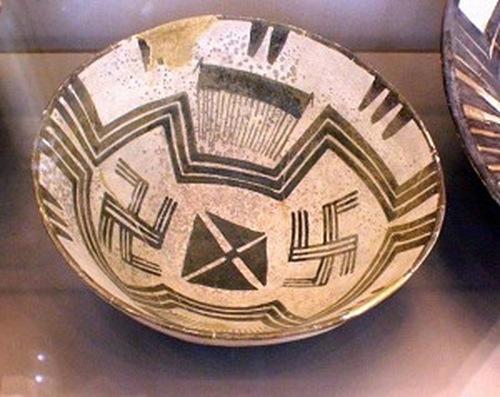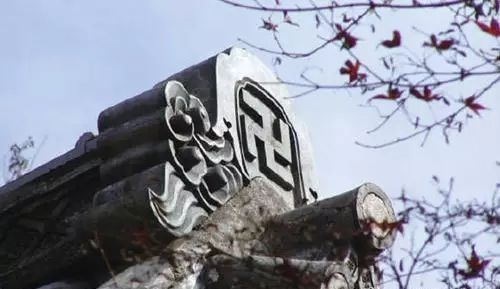(Minghui.org) World War II initiated by Hitler was the deadliest war in history with the highest human death count (especially the civilian death count). The Nazi’s genocide against the Jews has caused so much pain that human beings will never forget.
Many people think the 卍 symbol was the Nazi sign and are still afraid of it. However, this symbol has been with humankind throughout the civilization, dating back 6,000 years, or even 10,000 years ago. From the East to the West, from imperial palaces to cottages, this symbol could be seen everywhere – why did people like the 卍 symbol?
Does the 卍 symbol really belong to Hitler and the Nazis? Even if Hitler lived to today, he would be only 132 years old. The 卍 symbol, however, has been around for over 10,000 years.
For people today, what luck will the 卍 symbol bring to us?
Table of Contents:
Chapter I: The Auspicious Sign That People Knew At Least 6,000 Years AgoChapter II: The Swastika in Hopi ProphecyChapter III: The Lord Savior Has Returned
Prologue
Adolf Hitler was born in April 1889. As a former German politician and the Nazi party leader, he launched the Poland War in September 1939 and thus started World War II in Europe. He committed suicide on April 30, 1945, to avoid being captured as Germany was losing the war.
Hitler was one of the main planners and initiators of the Jewish Holocaust (1941-1945). Under his leadership, the Nazis slaughtered at least 5.5 million Jewish men, women, elderly, children, including the physically and mentally challenged. Meanwhile, World War II caused 29.3 million military and civilian deaths in Europe, becoming the deadliest war in human history, with the largest number of civilian deaths.
Not only did the war cause huge suffering for mankind that cannot be forgotten, but Hitler also left the world with many unforgettable impressions with his personal charisma, oratorical talent, and propaganda skills. The 卍 (swastika) symbol that he misused is the most notable example.
Nowadays, many people are scared of the 卍 symbol. They thought that it belongs to the Nazis and associate it with a dark meaning.
However, the 卍 symbol does not belong to Hitler and the Nazis at all. Even if Hitler lived to today, he would only be 132 years old. The 卍 symbol has been with mankind for 6,000 years or even over 10,000 years.
For example, the Hopi is an ancient Indian tribe living in the United States. They have a precious prophecy stone in the Hopi’s reserve. The stone has drawings of the most important prophecies for the Hopi tribe from over 10,000 years ago. There is a 卍 symbol with a significant meaning in the drawing.
As the humans suffer the COVID-19 pandemic, the 卍 symbol may contain a key message from the universe. Let’s spend a few minutes to go through the history to understand the 卍 symbol’s meaning.
Chapter I: The Auspicious Sign That People Knew at Least 6,000 Years Ago
The 卍 symbol was called “Srivatsa” in Sanskrit and “Swastika” in English. It means “Auspicious Sea Cloud” in Sanskrit. For example, the 卍 symbol at the chest of a Buddha means the manifestation of “Auspicious Sea Cloud.”
The 卍 symbol represents luck and positive energy of the universe. It has been depicted in many ancient civilizations from the East to the West.
The 卍 symbol was discovered in India and Central Asia around 2,500 B.C. A study in 1933 pointed out that the 卍 symbol might have gone from India, passed through Persia and Western Asia, and arrived in Greece around 1,000 B.C., then came to Italy and Germany.
The Sia Museum in Berlin, Germany has a collection of Samarra Plates from Iraq. Archaeologists believe that the plates date back to about 5,000 B.C. These plates have the 卍 figure in the center.
In France, the Louvre houses a Mesopotamian pottery bowl. This 6,000-year-old pottery bowl is also painted with the 卍 symbol.
The “Mesopotamian Civilization,” or the “Two Rivers Civilization,” refers to the ancient civilization developed on the fertile valleys between the Tigris and Euphrates rivers, located roughly in today’s Iraq.
That civilization has the cuneiform writing that the Sumerians invented around 3,200 B.C.; the Assyrian Library of Barnebas, which contains 24,000 clay tablets over 2,600 years ago; the Code of Hammurabi with its preface and postscript and 282 articles; the algebraic operations on trigonometry by the ancient Babylonians; and the accurate prediction of eclipses and lunar eclipses by the Babylonians in 747 B.C.
Amazingly, a Mesopotamian pottery bowl contains several 卍 figures.
In China, the Majiayao painted pottery jar in the Gansu Museum has the 卍 figure as its main motif. The jar is about 5,000 years old.
In England, a 4,000-year-old swastika-carved megaliths was found in Yorkshire.
The 卍 symbol was widely used in ancient Greece (800 B.C.). It was found on temple buildings and sacred vessels, as well as painted pottery vessels.
A grain jar excavated in Greece, made around 700 B.C., has a drawing of Artemis (the goddess of the hunt and goddess of the moon) with a circle of 卍 figures around her.
An amphora urn from the island of Syra in the collection of the National Archaeological Museum of Athens depicts the famous battle of Troy, dated around 900 B.C. It has three painted 卍 symbols above a horse.
The 卍 symbols were also marked on altars in ancient Rome (753-476 B.C.).
The 卍 symbol is connected to gods throughout human history. It was frequently seen in early Christianity age, and cherished and respected by the Christians. It was then seen more in house decorations and daily goods during the later age.
The 卍 symbol is everywhere in Buddhist regions, such as ancient India, Tibet, Japan, and South Korea. People in China and Southeast Asia associate the 卍 symbol with Buddha. In many ancient scriptures and paintings of Buddha, the Buddha’s chest carries the 卍 symbol.
In Israel, mosaic tiles with the 卍 figure were found from the ruins of the ancient town of Mamshit, dating from the 400 A.D.
All these discoveries of using the 卍 symbol brought to light the fact that the 卍 symbol has nothing to do with anti-Semitism, and that Hitler had brought the two things together.
Unfortunately, Hitler’s high-profile promotion of the 卍 symbol in black as the Nazi sign caught more people’s attention.
Fortunately, we have the freedom to make our own decision. If we choose to no longer associate the ancient 卍 symbol, which means good luck and positive energy, with the Nazis, then the symbol will no longer belong to Hitler as people had thought.
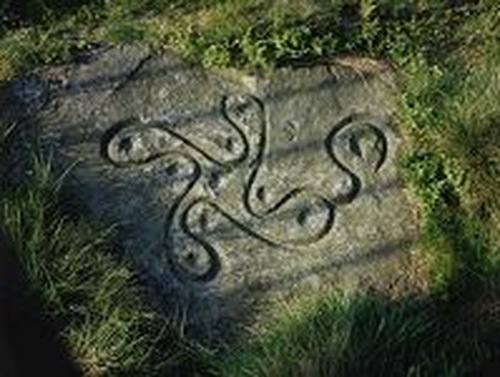 A 4,000-Year-Old Swastika-Carved Megalith in Yorkshire, England
A 4,000-Year-Old Swastika-Carved Megalith in Yorkshire, England
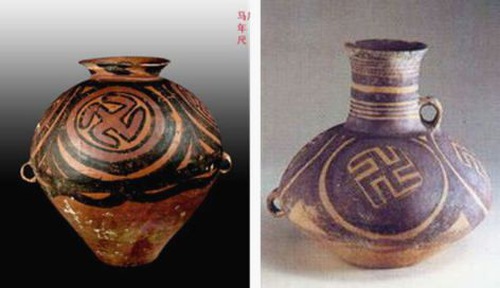 Majiayao Painted Pottery Jar from China
Majiayao Painted Pottery Jar from China
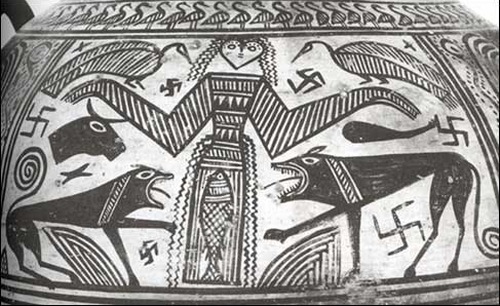 A Grain Jar Excavated in Greece
A Grain Jar Excavated in Greece
 The Big Buddha in Lantau Island, Hong Kong
The Big Buddha in Lantau Island, Hong Kong
 Mosaic Tiles With the 卍 Figure From Israel
Mosaic Tiles With the 卍 Figure From Israel
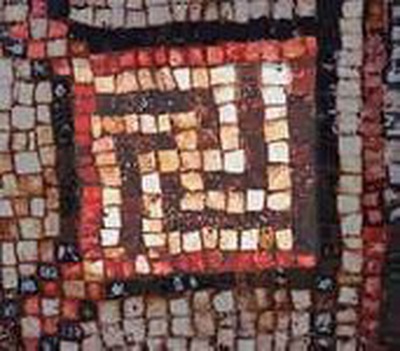 The 卍 Figures in the Porcelain Inlays of Israel’s Ancient Houses of Worship
The 卍 Figures in the Porcelain Inlays of Israel’s Ancient Houses of Worship
 The Black 卍 Symbol Used as the Nazi Sign by Hitler
The Black 卍 Symbol Used as the Nazi Sign by Hitler
(To be continued)
All articles, graphics, and content published on Minghui.org are copyrighted. Non-commercial reproduction is allowed but requires attribution with the article title and a link to the original article.
Category: Perspective





